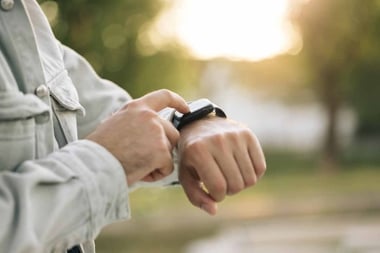Running the Risks: Running vs Walking
There is no simpler or more natural workout than walking. It's easy, inexpensive and a great way to get in shape.
There is no simpler or more natural workout than walking. It’s easy, inexpensive and a great way to get in shape. In fact, the evidence continues to mount that walking three times per week (not running or weight lifting) may be the most health conscious thing you can do for your body.
Walking for health and fitness can mean anything you want, from a mountain hike to a stroll along the beach. A walk with family and friends or a chance to get away from it all, think and unwind. It’s all up to you. You can do it anywhere, anytime. How about now?
Remember, even though walking is safe and dependable, always consult your doctor before beginning any sort of exercise program. Once you’ve received a clean bill of health, here are some helpful hints on how to get started.
Start slowly. Keep in mind, especially if you are just starting, that you have to return from your destination. Make sure you can cover the entire distance–not just the first part.
No matter how far you go or how fast, standing tall is the key. These "body positioning" tips will help you breathe easy and give you good back support for pain free walking:
- Keep your head up and your eyes straight ahead.
- Relax your shoulders and pull down and back with your shoulder blades.
- Keep your chest lifted.
- Keep your abs tight; don’t arch the low back or stick out the butt.
- Swing your arms with purpose, tight and strong (no flailing).
With each step, you should land squarely on your heels with the toes lifted high. Then roll the foot from heel to toe and really push off with the toes at the end of the stride. This allows the ankle to move through its complete range of motion and provides major propulsion as you gain speed.
Keep your stride to a comfortable length; don’t try to reach too far. Overstriding just wastes energy and ends up slowing you down.
Make sure you have a good pair of shoes and replace them often.
Walking is one of the most efficient low impact workouts available. There are no fees to pay, no special facilities to attend, and it’s as easy to do as strolling around the block.
As a form of exercise, walking is safe and offers a host of long term health benefits. You stand little chance of developing shin splints or tennis elbow (in fact, about the only way to injure yourself is by tripping). What you can expect is: lower blood pressure; lower risk of osteoporosis, cancer and heart disease; an improved cholesterol profile; fat loss; and a chance to clear your mind and lift your spirits.
Running
What could be easier? Just lace up your shoes, head out the door and turn right. Now keep going and you’re on your way to getting in shape. You can run from your home, office or while travelling. On your lunch hour, on the weekend or on vacation. Do it with a group of friends or meditate in solitude.
Once you’ve selected a pair of good running shoes and have received the okay from your doctor, here are some tips to help you get started:
Start by walking. Everyone needs to feel successful and comfortable when beginning a new fitness program. Try walking 20-30 minutes at a normal speed, until it feels easy.
Pick up the pace. Once normal walking becomes easy, walk briskly for the same 20-30 minute period, remembering to monitor your heart rate every five to 10 minutes.
When you are comfortable walking briskly and feel you want to step things up, simply insert three or four "jogs" into your 30 minute walk.
Now just continue to make the jogging portion of your walk longer, and the walking part shorter - until you are up to a 30 minute jog.
As your jogging becomes faster, remember to monitor your heart rate and slow down to a jog or walk whenever necessary.
Risks and Benefits
The health benefits of running (and walking) have been well documented, with just 30 minutes three times a week required to yield health results.
Running has a fitness edge over walking in two respects. First, runners use energy quicker than walkers. For although walking consumes about the same amount of energy per mile as running, it takes longer to walk a mile than to run one. Runners, therefore, can spend less time exercising to burn an equivalent number of calories. For example 20-30 minutes of running is equivalent to 40-50 minutes of walking.
Second, for many young people, brisk walking (about 6.5 kilometres per hour) may not raise their heart rate to the 60-80 percent that is their optimal training zone. So for them, running is a more efficient cardiovascular fitness exercise than walking.
Runners, however, have a greater risk of sustaining injuries such as strains, sprains, blisters and spurs. In fact, the risk factor for runners increases with the frequency and duration of the exercise. This is because the foot to surface impact ratio for running is three to four times your body weight compared to about one times your body weight for walking. The low impact of walking minimizes strain on the feet and joints and as a result there are fewer walking injuries. Consequently, studies show the drop out rate from running programs over a two year period is 50 per cent or more for running, compared to only 20 percent or less for walking.
The choice is yours.




